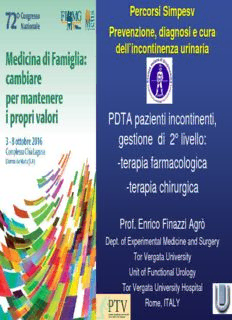
Enrico Finazzi Agrò PDF
Preview Enrico Finazzi Agrò
Percorsi Simpesv Prevenzione, diagnosi e cura dell’incontinenza urinaria PDTA pazienti incontinenti, gestione di 2° livello: -terapia farmacologica -terapia chirurgica Prof. Enrico Finazzi Agrò Dept. of Experimental Medicine and Surgery Tor Vergata University Unit of Functional Urology Tor Vergata University Hospital Rome, ITALY Behavioral Modification Timed Education voiding Behavioral Modification Pelvic floor Delayed exercises voiding Diet Bladder Training • Modify bladder function • Methods – bladder diary – gradually increase void interval – teach coping strategies • Strengthen pelvic floor muscles and improving bladder stability Management of Overactive Bladder • Behavioral therapies1 • Pharmacologic therapy • Combined pharmacologic and behavioral therapy provides improved outcomes2,3 1. MattiassonA. Urology. 2000;55(suppl 5a):12-13. 2. MattiassonA. Neuro Urodyn. 2001;20:403-404. 3. Burgio et al. JAGS. 2000;48:370-374. Drugs used in the treatment of OAB There are a number of pharmacological mechanisms that in theory could reduce overactive detrusor muscle activity. • Antimuscarinic drugs • Drugs acting on membrane channels • Drugs with mixed actions • Antidepressants • Alpha-adrenoreceptor antagonists • Beta-adrenoreceptor antagonists • PDE-5 inhibitors (for male LUTS/OAB) • ….However Toxins • Hormones EAU Guidelines, 2009 To date, the only approved treatments with Grade A recommendation based on level 1 evidence are anticholinergic drugs (specifically antimuscarinic) EAU Guidelines, 2009; Incontinence, 2009 Antimuscarinic drugs on the market Oxybutynin (IR 7.5-10mg/day, IR 15 mg/day, TDS 3.9-4 mg/day) Tolterodine (IR 2mg/day, IR 4 mg/day, ER 4mg/day) Propiverine, (IR 30mg/die, IR 45 mg/die, ER 20mg/die, ER 30 mg/die) Trospium, (40mg/die) Solifenacin (5mg/day, 10 mg/day) Darifenacin (7.15 mg/day, 15 mg/day) Fesoterodine (4 mg/day, 8 mg/day) Novara G., et al., Eur Urol, 2008
Description: